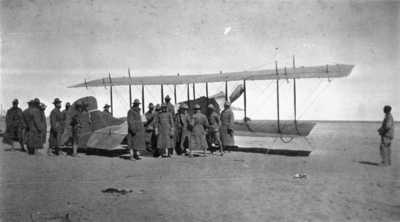1916-1917
Kentuckians Patrol the Border & See First Military Aircraft

Machine Gun Company of the 1st Kentucky Infantry Regiment in Texas along the Mexican border in 1917 (fighting Pancho Villa). They were outfitted with the Lewis Light Machine Gun which they mounted to the hood of their Model T Trucks.
The Kentucky National Guard Brigade was mobilized for the same punitive expedition in June 1916 and trained at Fort Thomas. In August 1916 they moved to Fort Bliss, near El Paso, Texas. They were stationed at Camp Owen Bierne some two miles from Fort Bliss. They were attached to the 10th US Provisional Division under command of BG Charles G. Morton. Their mission was to conduct patrols along a sixty-mile-stretch of the Rio Grande River to Fort Hancock. In February 1917 they were ordered back to Fort Thomas and mustered out.
The Kentuckians probably got their first opportunity to see military aircraft in action as the 1st Aero Squadron conducted operations and messenger services in the area. It may have even been the first airplane many of them had ever seen.
Kentucky furnished 2,394 troops for the Mexican Border campaign, suffering an unknown number of casualties.
1LT Nathaniel G. Hale, Co. L., 3rd Kentucky Infantry died of an accidental gunshot wound at Ft. Bliss Texas on 13 January 1917. Hale belonged to the Murray unit, joining as a private on June 22, 1912. He was promoted to Sergeant and First Sergeant and elected 1LT on July 10, 1914.
Several members of the Kentucky Guard perished on the border or after returning home from Pneumonia and other communicable diseases. As was often the case, camp life held as many dangers from disease as duty on the front lines from bullets.

KYNG members gather around a Signal Corps plane taken sometime between August 1916 and February 1917. This is believed to be Signal Corps plane No. 75, A Curtis R2, which was delivered to Columbus in May 1916. Courtesy Kentucky Historical Society Cheshire Collection.
Harold Hite of Company A, Third Regiment died on 4 February 1917 of Pneumonia. Capt. Estel E. Owsley, Company M. Second Kentucky Regiment of Middlesboro died February 11, 1917 at Fort Thomas, Kentucky. He took ill on the trip from El Paso to Kentucky. Claude Somerville of Portland Tenn. died at the city hospital on 25 March 1917 following surgery. He had been ill with measles and later developed pneumonia and after recovering from that became ill from emphysema. He enlisted in the Third Regiment of the Kentucky National Guard in Franklin, Kentucky. There were undoubtedly many others whom research has not yet revealed and newspaper accounts make references to widespread illness from pneumonia.
Company A Signal Corps KYNG Circa 1916

Company A Signal Corps Kentucky National Guard. In front of the Water Tower at Fort Thomas Ky circa 1916. Courtesy LTC Robert P. Watson
Additional Resources
Primary Sources
- General Order No. 1 dated January 20, 1917, General Order Book, 1917.
- The Courier Journal 5 Feb 1917 P 14, Col. 8
- The Courier Journal 12 Feb 1917 P 9
- Courier Journal 26 March 1917 p 10 col. 5.
- The Courier Journal 5 Feb 1917 P 14, Col. 8